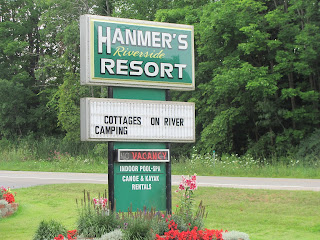Learning about the Great Lakes Salmon
When Al and I made reservations at a resort
near Lake Michigan for a week, we were told it was the season for the salmon
run in the Betsie River which wound through the property. Dozens of fishermen
were staying at the resort from mid-August through mid-September. Neither of us
had ever experienced a salmon run before. It sounded like a great new
adventure.
We stayed in a small, but fully supplied
cabin that had a great view of the river and were enthralled by the sight of
the huge fish swimming upstream. A sign taped to the refrigerator door listed
several rules pertaining to the fishing guests at the resort. To someone who
doesn’t fish much, the following seemed humorous: “1) Do not wear waders inside cabin 2)
Uncleaned fish and coolers are not permitted inside cabins 3) No canning in
cabins. Canning is permitted outside and away from your cabin on your own gas
cooker.” Canning on that small range with the strange assortment of pots and
pans provided would be very difficult anyway.
Another rule stated: “If you will be tying
spawn in the cabin, it needs to be done on several layers of newspaper and
removed from cabin when finished.” Tying
spawn? I had to look that one up. It referred to making tiny net bags
containing fish eggs to use as bait. The rules gave me a good picture of what
the owners of the resort faced during fishing season and an insight into a
whole different world.
How about the world of the salmon? It came as a surprise to learn that the Great
Lakes are stocked with Coho and Chinook salmon every year. Adapted to living in
fresh water, they feed and grow for three years before migrating back to the
place of their origin. This necessitates navigating up the rivers that empty
into the Great Lakes to finally spawn and then die.
Although we didn’t fish, generous neighbors
at the resort shared enough salmon steaks with us for two wonderful meals. A
popular place for fishermen was at Homestead Dam, several miles upstream from
the resort, where the salmon congregated below the dam before jumping up a
man-made ladder. They had to clear a
couple of major hurdles before skimming over the cement top of the dam and
swimming off into the strong current once again.
Our daughter Shanda and her family joined us
on the overlook of the dam to watch the amazing sight. It was quite exciting to
see the salmon hurdle the ladder, some falling short and landing back into the
foaming white water. Once over this obstacle, the end would come…if not by a
fisherman, then a short time after the eggs were laid at the spawning grounds.
We watched a fisherman bring a big one to
shore just below the dam. It fought bravely but after several minutes gave up
in exhaustion. This salmon, about 25 pounds, had been snagged on the side
rather than being hooked on the lip as required by law and was released back
into the river.
It was sad thinking about the demise of
these beautiful fish. When I mentioned that to Shanda, she commented that it
was part of the cycle of life. Thanks to their courageous efforts, new fish
would be produced, food for humans and predators would be supplied and the
decomposing fish would provide fertile compost for the land.
And what about our purpose? Above all, we
were created to have fellowship with God, our Heavenly Father, and to love one
another. Our lives will be filled with meaning and joy as we fulfill His plan
for us.
“There is a time for everything and a season
for every activity under heaven…” Ecclesiastes 3:1 NIV






.jpg)

Comments
Post a Comment